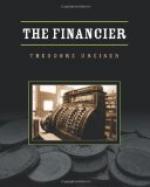The day had now become cloudy, lowery, and it looked as if there might be snow. Eddie Zanders, who had been given all the papers in the case, announced that there was no need to return to the county jail. In consequence the five of them—Zanders, Steger, Cowperwood, his father, and Edward—got into a street-car which ran to within a few blocks of the prison. Within half an hour they were at the gates of the Eastern Penitentiary.
Chapter LIII
The Eastern District Penitentiary of Pennsylvania, standing at Fairmount Avenue and Twenty-first Street in Philadelphia, where Cowperwood was now to serve his sentence of four years and three months, was a large, gray-stone structure, solemn and momentous in its mien, not at all unlike the palace of Sforzas at Milan, although not so distinguished. It stretched its gray length for several blocks along four different streets, and looked as lonely and forbidding as a prison should. The wall which inclosed its great area extending over ten acres and gave it so much of its solemn dignity was thirty-five feet high and some seven feet thick. The prison proper, which was not visible from the outside, consisted of seven arms or corridors, ranged octopus-like around a central room or court, and occupying in their sprawling length about two-thirds of the yard inclosed within the walls, so that there was but little space for the charm of lawn or sward. The corridors, forty-two feet wide from outer wall to outer wall, were one hundred and eighty feet in length, and in four instances two stories high, and extended in their long reach in every direction. There were no windows in the corridors, only narrow slits of skylights, three and one-half feet long by perhaps eight inches wide, let in the roof; and the ground-floor cells were accompanied in some instances by a small yard ten by sixteen—the same size as the cells proper—which was surrounded by a high brick wall in every instance. The cells and floors and roofs were made of stone, and the corridors, which were only ten feet wide between the cells, and in the case of the single-story portion only fifteen feet high, were paved with stone. If you stood in the central room, or rotunda, and looked down the long stretches which departed from you in every direction, you had a sense of narrowness and confinement not compatible with their length. The iron doors, with their outer accompaniment of solid wooden ones, the latter used at times to shut the prisoner from all sight and sound, were grim and unpleasing to behold. The halls were light enough, being whitewashed frequently and set with the narrow skylights, which were closed with frosted glass in winter; but they were, as are all such matter-of-fact arrangements for incarceration, bare—wearisome to look upon. Life enough there was in all conscience, seeing that there were four hundred prisoners here at that time, and that nearly every cell was occupied; but it was a life of




